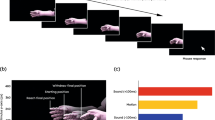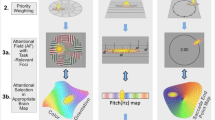Abstract
Current behavioural theories consider that during motor learning, an effector-independent memory representation of the acquired skill is built up. Using a transfer paradigm, we addressed the nature of the memory representation for a 2:1 multifrequency co-ordination task, requiring, for example, the left arm to cycle twice as fast as the right. After learning this 2:1 pattern, transfer to its converse pattern (i.e., the right arm cycles twice as fast as the left) revealed powerful evidence for negative transfer. The converse task arrangement revealed similar effects. These observations suggest a reconsideration of current viewpoints on movement representations, which emphasize effector independence. Based on the present findings, we propose a new model of motor memory, consisting of an abstract, effector-independent and an effector-specific layer. The abstract code is hypothesized to represent general spatiotemporal movement features, whereas the specific representation refers to effector-related movement commands. This concept is consistent with recent neuroscientific evidence in animal and human species, and invites a reconsideration of current behavioural theories of motor learning and memory.







Similar content being viewed by others
References
Bapi RS, Doya K, Harner AM (2000) Evidence for effector independent and dependent representations and their differential time course of acquisition during motor sequence learning. Exp Brain Res 132:149–162
Brasil-Neto JP, Valls-Sole J, Pascual-Leone A, Cammarota A, Amassian VE, Cracco R, Maccabee P, Cracco J, Hallett M, Cohen LG (1993) Rapid modulation of human cortical motor outputs following ischaemic nerve block. Brain 116(Pt 3):511–525
Cisek P, Crammond DJ, Kalaska JF (2003) Neural activity in primary motor and dorsal premotor cortex in reaching tasks with the contralateral versus ipsilateral arm. J Neurophysiol 89:22–942
Cohen LG, Roth BJ, Wassermann EM, Topka H, Fuhr P, Schultz J, Hallett M (1991) Magnetic stimulation of the human cerebral cortex, an indicator of reorganization in motor pathways in certain pathological conditions. J Clin Neurophysiol 8:56–65
Criscimagna-Hemminger SE, Donchin O, Gazzaniga MS, Shadmehr R (2003) Learned dynamics of reaching movements generalize from dominant to nondominant arm. J Neurophysiol 89:168–176
de Jong BM, Leenders KL, Paans AM (2002) Right parieto-premotor activation related to limb-independent antiphase movement. Cereb Cortex 12:1213–1217
Debaere F, Wenderoth N, Sunaert S, Van Hecke P, Swinnen SP (2004) Changes in brain activation during the acquisition of a new bimanual coordination task. Neuropsychologia 42:855–867
Gandolfo F, Li C, Benda BJ, Schioppa CP, Bizzi E (2000) Cortical correlates of learning in monkeys adapting to a new dynamical environment. Proc Natl Acad Sci U S A 97:2259–2263
Gordon AM, Forssberg H, Iwasaki N (1994) Formation and lateralization of internal representations underlying motor commands during precision grip. Neuropsychologia 32:555–568
Grafton ST, Hazeltine E, Ivry RB (1998) Abstract and effector-specific representations of motor sequences identified with PET. J Neurosci 18:9420–9428
Grafton ST, Hazeltine E, Ivry RB (2002) Motor sequence learning with the nondominant left hand. A PET functional imaging study. Exp Brain Res 146:369–378
Imamizu H, Uno Y, Kawato M (1998) Adaptive internal model of intrinsic kinematics involved in learning an aiming task. J Exp Psychol Hum Percept Perform 24:812–829
Japikse KC, Negash S, Howard JH Jr, Howard DV (2003) Intermanual transfer of procedural learning after extended practice of probabilistic sequences. Exp Brain Res 148:38–49
Keele SW, Jennings P, Jones S, Caulton D, Cohen A (1995) On the modularity of sequence representation. J Mot Behav 27:17–30
Kelso JAS, Zanone PG (2002) Coordination dynamics of learning and transfer across different effector systems. J Exp Psychol Hum Percept Perform 28:776–797
Kelso JA, Southard DL, Goodman D (1979) On the coordination of two-handed movements. J Exp Psychol Hum Percept Perform 5:229–238
Kelso JAS, Scholz JP, Schöner G (1986) Non-equilibrium phase transitions in coordinated biological motions: Critical fluctuations. Phys Lett A 118:279–284
Kleim JA, Barbay S, Cooper NR, Hogg TM, Reidel CN, Remple MS, Nudo RJ (2002) Motor learning-dependent synaptogenesis is localized to functionally reorganized motor cortex. Neurobiol Learn Mem 77:63–77
Krakauer JW, Pine ZM, Ghilardi MF, Ghez C (2000) Learning of visuomotor transformations for vectorial planning of reaching trajectories. J Neurosci 20:8916–8924
Kuhtz-Buschbeck JP, Mahnkopf C, Holzknecht C, Siebner H, Ulmer S, Jansen O (2003) Effector-independent representations of simple and complex imagined finger movements: a combined fMRI and TMS study. Eur J Neurosci 18:3375–3387
Li CS, Padoa-Schioppa C, Bizzi E (2001) Neuronal correlates of motor performance and motor learning in the primary motor cortex of monkeys adapting to an external force field. Neuron 30:593–607
Morton SM, Lang CE, Bastian AJ (2001) Inter- and intra-limb generalization of adaptation during catching. Exp Brain Res 141:438–445
Muellbacher W, Ziemann U, Wissel J, Dang N, Kofler M, Facchini S, Boroojerdi B, Poewe W, Hallett M (2002) Early consolidation in human primary motor cortex. Nature 415:640–644
Oldfield RC (1971) The assessment and analysis of handedness: the Edinburgh inventory. Neuropsychologia 9:97–113
Pascual-Leone A, Nguyet D, Cohen LG, Brasil-Neto JP, Cammarota A, Hallett M (1995) Modulation of muscle responses evoked by transcranial magnetic stimulation during the acquisition of new fine motor skills. J Neurophysiol 74:1037–1045
Rijntjes M, Dettmers C, Buchel C, Kiebel S, Frackowiak RS, Weiller C (1999) A blueprint for movement: functional and anatomical representations in the human motor system. J Neurosci 19:8043–8048
Rioult-Pedotti MS, Friedman D, Hess G, Donoghue JP (1998) Strengthening of horizontal cortical connections following skill learning. Nat Neurosci 1:230–234
Sainburg RL, Wang J (2002) Interlimb transfer of visuomotor rotations: independence of direction and final position information. Exp Brain Res 145:437–447
Sanes JN, Donoghue JP (2000) Plasticity and primary motor cortex. Annu Rev Neurosci 23:393–415
Schmidt RA (1975) A schema theory of discrete motor skill learning. Psychol Rev 82:225–260
Schmidt RC, Treffner PJ, Shaw BK, Turvey MT (1992) Dynamical aspects of learning an interlimb rhythmic movement pattern. J Mot Behav 24:67–83
Shadmehr R, Mussa-Ivaldi FA (1994) Adaptive representation of dynamics during learning of a motor task. J Neurosci 14:3208–3224
Swinnen SP, Dounskaia N, Walter CB, Serrien DJ (1997) Preferred and induced coordination modes during the acquisition of bimanual movements with a 2:1 frequency ratio. J Exp Psychol Hum Percept Perform 23:1087–1110
Temprado JJ, Swinnen SP (2005) Dynamics of learning and transfer of muscular and spatial relative phase in bimanual coordination: evidence for abstract directional codes. Exp Brain Res 160:180–188
Thut G, Cook ND, Regard M, Leenders KL, Halsband U, Landis T (1996) Intermanual transfer of proximal and distal motor engrams in humans. Exp Brain Res 108:321–327
Wang J, Sainburg RL (2004) Interlimb transfer of novel inertial dynamics is asymmetrical. J Neurophysiol 92:349–360
Wigmore V, Tong C, Flanagan JR (2002) Visuomotor rotations of varying size and direction compete for a single internal model in motor working memory. J Exp Psychol Hum Percept Perform 28:447–457
Wright C (1990) Generalized motor programs: reexamining claims of effector independence in writing. In: Jeannerod M (eds) Attention and performance XIII: motor representation and control. Erlbaum Associates, Hillsdale, pp 294–320
Zanone PG, Kelso JA (1997) Coordination dynamics of learning and transfer: collective and component levels. J Exp Psychol Hum Percept Perform 23:1454–1480
Acknowledgement
Sophie Vangheluwe was supported by the Fund for Scientific Research-Flanders. Additional support was provided through a grant from the Research Council of K.U. Leuven, Belgium (contract no. OT/03/61) and the National Fund for Scientific Research, Belgium (project G.0460.04 and G.0105.05), awarded to S. Swinnen. Reprint requests should be sent to S. Vangheluwe, Motor Control Laboratory, K.U. Leuven, Tervuursevest 101, 3001 Leuven, Belgium.
Author information
Authors and Affiliations
Corresponding author
Rights and permissions
About this article
Cite this article
Vangheluwe, S., Suy, E., Wenderoth, N. et al. Learning and transfer of bimanual multifrequency patterns: effector-independent and effector-specific levels of movement representation. Exp Brain Res 170, 543–554 (2006). https://doi.org/10.1007/s00221-005-0238-0
Received:
Accepted:
Published:
Issue Date:
DOI: https://doi.org/10.1007/s00221-005-0238-0




